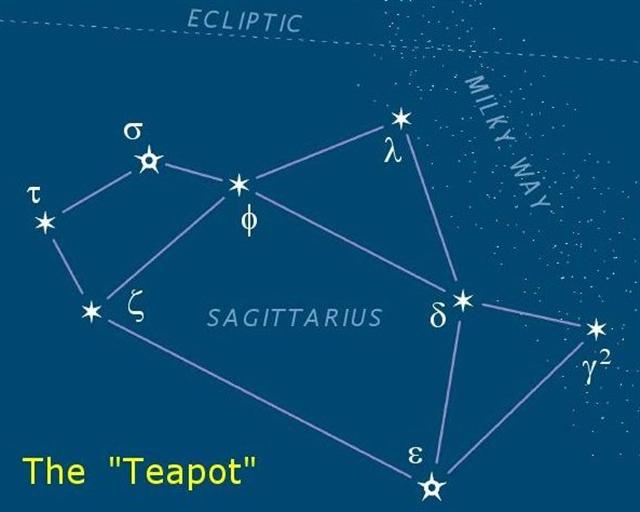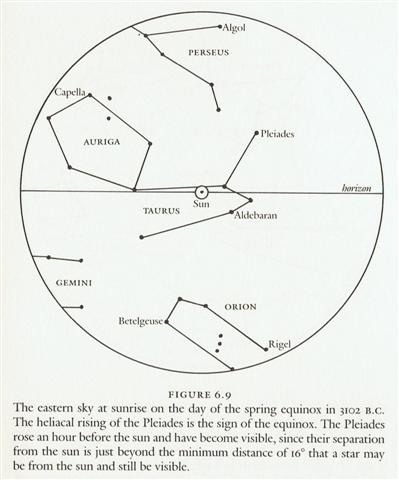177. These 5 days before 0h could alternatively have been regarded as belonging in the previous year and then the star sequence ruling time in the G text would primarily stretch from May 24 to June 30, for 230 + 173 = 403 (= 31 * 13) days. Or in short:
Deneb Okab was the Tail of the Old Eagle and Sirius was always moving hand in hand with the Sun, rising earlier and earlier in the year due to the precession.
... The Sothic cycle was based on what is referred to in technical jargon as 'the periodic return of the heliacal rising of Sirius', which is the first appearance of this star after a seasonal absence, rising at dawn just ahead of the sun in the eastern portion of the sky. In the case of Sirius the interval between one such rising and the next amounts to exactly 365.25 days - a mathematically harmonious figure, uncomplicated by further decimal points, which is just twelve minutes longer than the duration of the solar year ... Yet, the G text was obviously designed to document also the positions of Sirius among the other stars: ... the Little Eyes are Matariki, and at one time but a single star, so bright that their god Tane in envy got hold of Aumea, our Aldebaran, and, accompanied by Mere, our Sirius, chased the offender, who took refuge in a stream. Mere, however, drained off the water, and Tane hurled Aumea at the fugitive, breaking him into the six pieces that we now see, whence the native name for the fragments, Tauono, the Six, quoted by Flammarion as Tau, both titles singularly like the Latin Taurus. They were the favorite one of the various avelas, or guides at sea in night voyages from one island to another; and, as opening the year, objects of worship down to 1857, when Christianity prevailed throughout these islands [the Hervey group] ...First we will find the great fish-hook of Mere at ºJune 30, when at the time of Gregory XIII Sirius had risen together with the Sun, and then another fish-hook marked where Sirus had been in Roman times, *27 precessional days later in the text - but here its position was at the other side of the year, i.e. close to the Full Moon:
Nunki (σ Sagittarii) was well known as the star who announced the beginning of 'Water'. A fish-hook half a year later would therefore be easy to associate with Sirius because in ancient Egypt when Sirius rose heliacally it caused the waters of the Nile to rise - though in ancient Egypt everything was 'upside down' (with up in the south instead of in the north) and therefore a more normal perspective would mean heliacal Sirius should be where Land would rise up again from the waters. Mere drained of the water - much like the preceding Agastya (Canopus). ... The Pythagoreans make Phaeton fall into Eridanus, burning part of its water, and glowing still at the time when the Argonauts passed by. Ovid stated that since the fall the Nile hides its sources. Rigveda 9.73.3 says that the Great Varuna has hidden the ocean. The Mahabharata tells in its own style why the 'heavenly Ganga' had to be brought down. At the end of the Golden Age (Krita Yuga) a class of Asura who had fought against the 'gods' hid themselves in the ocean where the gods could not reach them, and planned to overthrow the government. So the gods implored Agastya (Canopus, alpha Carinae = Eridu) for help. The great Rishi did as he was bidden, drank up the water of the ocean, and thus laid bare the enemies, who were then slain by the gods. But now, there was no ocean anymore! Implored by the gods to fill the sea again, the Holy One replied: 'That water in sooth hath been digested by me. Some other expedient, therefore, must be thought of by you, if ye desire to make endeavour to fill the ocean ...
... This [σ Sagittarii] has been identified with Nunki of the Euphratean Tablet of the Thirty Stars, the Star of the Proclamation of the Sea, this Sea being the quarter occupied by Aquarius, Capricornus, Delphinus, Pisces, and Pisces Australis. It is the same space in the sky that Aratos designated as Water ...
... Pliny wants to assure us that 'the whole sea is conscious of the rise of that star [Sirius], as is most clearly seen in the Dardanelles, for sea-weed and fishes float on the surface, and everything is turned up from the bottom'. He also remarks that at the rising of the Dog-Star the wine in the cellars begins to stir up and that the still waters move ... ... In Polynesia the myths told about how new Land was fished up by Maui (or some other hero) and this idea resembles how sea-weed and fishes were drawn up by Sirius (making the still waters come alive) ...
|
|||||||||||||||||||||||||||||||||||||||||||||||||||||||||||||||||||||||||||||||||||||||||||||||||||||||||||||||||||||||||||||||||||||||||||||||||||||||||||||||||||||||||||||||||||||||||||||||||||||||||||||||||||||||||||||||||||||||||||||||||||||||||||||||||||||||


 1 winter solstice
1 winter solstice


























